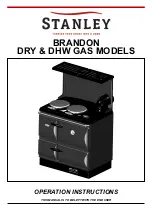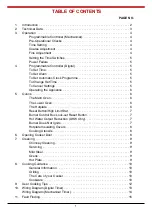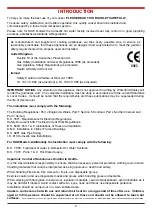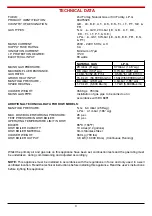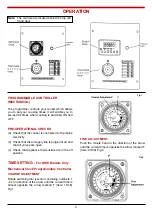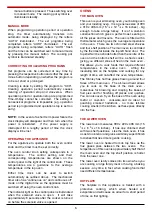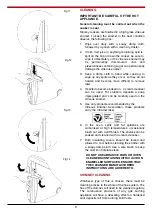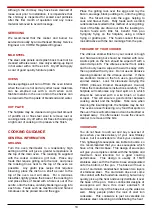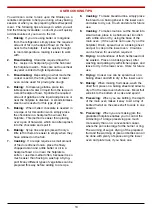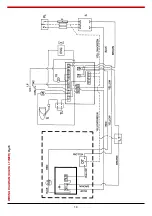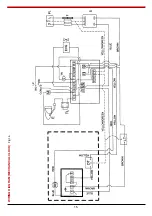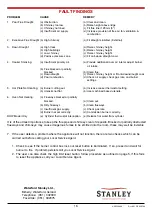
10
Although, the chimney may have been cleaned of
loose soot prior to installation, it is imperative that
the chimney is inspected for scaled soot particles
after the first month of operation and any loose
material removed to avoid blockage.
SERVICING
We recommend that the cooker and burner be
serviced annually by an Authorised Stanley Service
Engineer or a CORGI Registered Engineer.
MILD STEEL
The steel side panels and splash back must not be
cleaned with steel wool. Use only washing-up liquid
in hot water with a lint free cloth. Dry off and apply
a coat of good quality furniture polish.
OVENS
Grease spillages will burn off from the oven interior
when the oven is hot and any other loose materials
can be emptied out with a cloth when cold.
Stubborn stains in the oven and on the shelves can
be cleaned off with a paste of bread soda and water.
HOT PLATE
The hotplate may be cleaned using a small amount
of paraffin oil or fine steel wool to remove rust or
cooking stains, dry off with a lint free cloth and apply
a light coat of cooking oil to preserve the finish.
COOKING GUIDANCE
GENERAL INFORMATION
GRILLING
Turn the oven thermostat to a reasonably high
setting and this will give a greater temperature at
the top of the main oven. The roasting tin supplied
with the cooker contains a grill rack. Place any
foods that require grilling onto the rack, and place
the roasting tin as near to the top of the oven as
possible. Any gratin type recipe that requires
browning, place the dish on a shelf as near to the
top of the oven as it will allow. For a delicious
breakfast, lightly grease the base of the roasting tin
and place slices of bread with a hole cut out of the
centre, onto the base, carefully breaking an egg into
each hole. Foods such as mushrooms and halved
tomatoes can be placed around the eggs.
Place the grilling rack over the eggs and lay the
bacon, sausage, black pudding etc., onto the grilling
rack. The fat will drop onto the eggs, helping to
cook and flavour them. Fatty foods such as lamb
cutlets are best suited to this method of oven grilling,
most of the fats are drawn out into the roasting tin.
Certain foods with little fat, benefit from pan
frying/dry frying on the hotplate, using a ribbed
frying or griddle pan. The foods cooked this way
look attractive with the bar markings from the pan.
THE CARE OF YOUR COOKER
The vitreous enamel finish on your cooker is tough
and hard wearing but should be treated with care.
Acidic spills on the hob should be wiped off with a
clean damp cloth. The vitreous enamel front, sides
and hob only need a wipe with a warm soapy cloth,
then a polish with a dry one. Do not use an abrasive
cleaning material on the vitreous enamel. If there
are stubborn marks on the hob, use a good quality
enamel cleaner. Look for cleansers carrying the
VEDC (Vitreous Enamel Development Council)
Follow the manufacturers instructions carefully. The
hotplate will carbonise any food spilt on it, which
should be removed with a wire brush or metal
scraper. This will ensure a good contact between
cooking utensil and the hotplate. Take care when
cleaning the insulating lids, the hotplate may be hot.
The ovens are self cleaning, any food that spills on
the oven floors will carbonise and can be brushed or
scraped away. It is often easier to use the vacuum
cleaner to remove all the bits.
COOKWARE
You do not have to rush out and buy a new set of
pans when you take delivery of your new Stanley
cooker, but it is advisable to check your cookware.
Thin, lightweight saucepans are liable to buckle, so
it is recommended that you use saucepans which
have a flat, thermic base. This design of saucepan
will give you complete contact with the hotplate and
maximum heat retention for a good cooking
performance. This design is usually of 18/20
stainless steel, with the thermic base encapsulated
onto the bottom of the pan. The base will have a
core of aluminium sandwiched between two layers
of stainless steel. The aluminium does not come
into contact with the food while cooking, but will very
quickly pick up the heat and evenly distribute it over
the base of the pan. Some continental designs of
saucepans will have this inner sandwich of
aluminium, not only at the base but up the sides as
well. Many people prefer the look of cast iron
cookware. This cookware is just as versatile as
stainless steel, absorbing and distributing the heat

